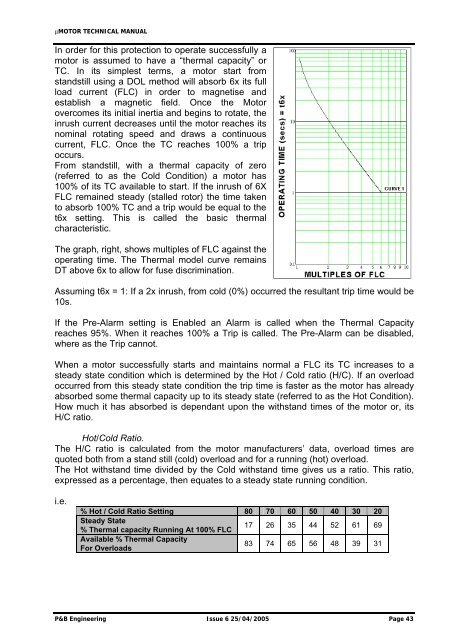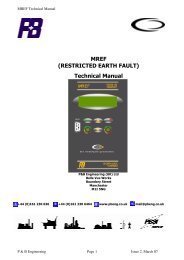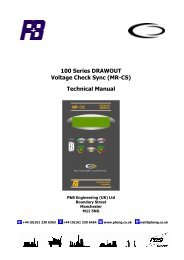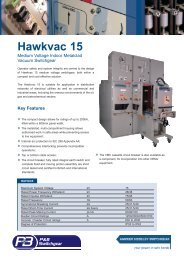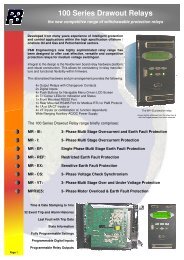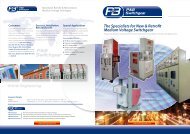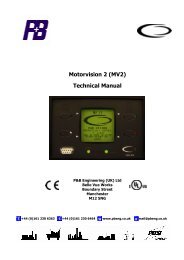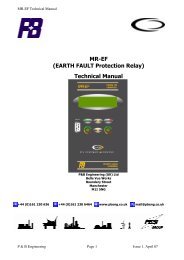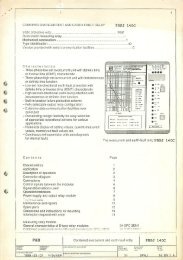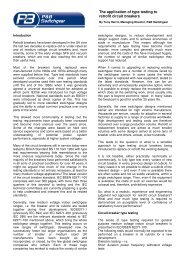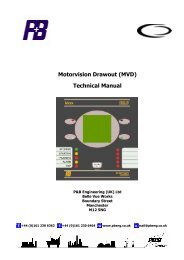(µMOTOR) Technical Manual - PBSI Group Ltd
(µMOTOR) Technical Manual - PBSI Group Ltd
(µMOTOR) Technical Manual - PBSI Group Ltd
You also want an ePaper? Increase the reach of your titles
YUMPU automatically turns print PDFs into web optimized ePapers that Google loves.
mMOTOR TECHNICAL MANUAL<br />
In order for this protection to operate successfully a<br />
motor is assumed to have a “thermal capacity” or<br />
TC. In its simplest terms, a motor start from<br />
standstill using a DOL method will absorb 6x its full<br />
load current (FLC) in order to magnetise and<br />
establish a magnetic field. Once the Motor<br />
overcomes its initial inertia and begins to rotate, the<br />
inrush current decreases until the motor reaches its<br />
nominal rotating speed and draws a continuous<br />
current, FLC. Once the TC reaches 100% a trip<br />
occurs.<br />
From standstill, with a thermal capacity of zero<br />
(referred to as the Cold Condition) a motor has<br />
100% of its TC available to start. If the inrush of 6X<br />
FLC remained steady (stalled rotor) the time taken<br />
to absorb 100% TC and a trip would be equal to the<br />
t6x setting. This is called the basic thermal<br />
characteristic.<br />
The graph, right, shows multiples of FLC against the<br />
operating time. The Thermal model curve remains<br />
DT above 6x to allow for fuse discrimination.<br />
Assuming t6x = 1: If a 2x inrush, from cold (0%) occurred the resultant trip time would be<br />
10s.<br />
If the Pre-Alarm setting is Enabled an Alarm is called when the Thermal Capacity<br />
reaches 95%. When it reaches 100% a Trip is called. The Pre-Alarm can be disabled,<br />
where as the Trip cannot.<br />
When a motor successfully starts and maintains normal a FLC its TC increases to a<br />
steady state condition which is determined by the Hot / Cold ratio (H/C). If an overload<br />
occurred from this steady state condition the trip time is faster as the motor has already<br />
absorbed some thermal capacity up to its steady state (referred to as the Hot Condition).<br />
How much it has absorbed is dependant upon the withstand times of the motor or, its<br />
H/C ratio.<br />
Hot/Cold Ratio.<br />
The H/C ratio is calculated from the motor manufacturers’ data, overload times are<br />
quoted both from a stand still (cold) overload and for a running (hot) overload.<br />
The Hot withstand time divided by the Cold withstand time gives us a ratio. This ratio,<br />
expressed as a percentage, then equates to a steady state running condition.<br />
i.e.<br />
% Hot / Cold Ratio Setting 80 70 60 50 40 30 20<br />
Steady State<br />
% Thermal capacity Running At 100% FLC<br />
17 26 35 44 52 61 69<br />
Available % Thermal Capacity<br />
For Overloads<br />
83 74 65 56 48 39 31<br />
P&B Engineering Issue 6 25/04/2005 Page 43


